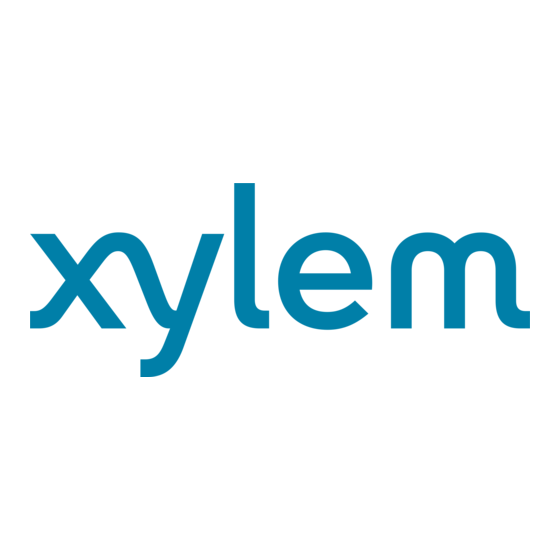
Table of Contents
Advertisement
Quick Links
Advertisement
Table of Contents

Subscribe to Our Youtube Channel
Summary of Contents for Xylem HYPACK DREDGEPACK
- Page 1 DREDGEPACK® DREDGEPACK® INSTALLATION MANUAL FOR CRANES Initial Release...
-
Page 2: Table Of Contents
INSTALLATION MANUAL FOR CRANES DREDGEPACK® Thank you for your purchase of this Crane System. Every effort has been made to ensure this system is ready for installation directly from the case in which it has been shipped to you. All components have been bench tested for complete functionality of the system. It is our desire to provide you with the best system possible and to fully support all aspects of your new HYPACK Crane System. -
Page 3: Safety Precautions
DREDGEPACK® I. Safety Precautions General Safety Precautions: • Conduct a thorough risk assessment before starting the installation. • Ensure that all personnel involved are properly trained in handling equipment and working at heights. • Use appropriate personal protective equipment (PPE) such as helmets, gloves, safety goggles, and harnesses. •... -
Page 4: Equipment Overview
DREDGEPACK® II. Equipment Overview Each DREDGEPACK® system for cranes is individually designed to fit the customer’s needs. The following sen- sors are required for the correct operation of the Crane System with DREDGEPACK®. There are some optional sensors presented that are needed only in special cases. When you receive your equipment, please verify it is complete. -
Page 5: Installation Instructions
DREDGEPACK® III. Installation Instructions A: Main Interface Box The main interface box connects to the monitor, so it should be installed near the cab. When it cannot be installed inside the cabin, it is neces- sary to add some extra protection to increase its lifespan and avoid damaging any sensors. -
Page 6: Dual Antenna Gnss Receiver
DREDGEPACK® B: Dual Antenna GNSS Receiver DREDGEPACK® requires the crane’s position and heading. The best method to obtain this data is to use a dual antenna GNSS receiver. - Crane Position: The main antenna can be used for cal- culating the position and elevation of the crane. For the best performance, the GNSS receiver can be upgraded to have a low uncertainty using RTK (Real Time Kinematic) calculations and should be be combined with a source of... -
Page 7: Angle Sensor (Port T7)
DREDGEPACK® The antennas require a 5/8-11 UNC bolt or threaded rod. WARNING: DO NOT WELD THE SCREW WHILE THE ANTENNA IS SCREWED IN. THAT COULD DAM- AGE THE ANTENNA SERIOUSLY. Either antenna can be assigned as the main antenna. It is important to identify the cable of the main antenna because it must be connected to Port 1 of the GNSS receiver. -
Page 8: Rotation Sensor (Port Hd25A)
DREDGEPACK® D: Rotation Sensor (Port HD25A): The rotation sensor calculates the payout of the holding cable, which in turn calculates the depth of the cutting tool. This device needs to be installed with the wheel of the sensor in constant contact with the holding drum. -
Page 9: Cab Box And Monitor
DREDGEPACK® E. Cab Box and Monitor The cab box powers the monitor and connects the mouse and keyboard to the main interface box. This box should be installed in the cab of the crane, close to the monitor. The monitor comes with a monitor stand that will sit flat on a desktop surface. -
Page 10: Barge Positioning System (Optional)
DREDGEPACK® F: Barge Positioning System (Optional) If the position and heading of the barge is needed, a separate dual GNSS system will need to be purchased, as well as two Wi-Fi radios. One radio will connect to the main interface box and one radio will connect to the GNSS system. -
Page 11: Remote Viewing Computer
DREDGEPACK® G. Remote Viewing Computer It is also possible for a remote computer to access the DREDGEPACK® network. For example, a tug captain may want to see the DREDGPACK® screen to adjust their path or position the crane in a certain location. This is also possible through the Wi-Fi radios if you have another unrestricted computer. -
Page 12: Maintenance And Care
DREDGEPACK® IV. Maintenance and Care • Regular cleaning: Wipe down the GNSS receiver, cables, and antennas with a soft, dry cloth to remove dust, dirt, and debris. This can help prevent damage and ensure proper functionality. • Cable inspection: Check the cables for any signs of wear, fraying, or damage. Replace any damaged cables to prevent signal loss or data errors. - Page 13 Unparalleled technical support HYPACK – A Xylem brand has been a world leader in software development for the hydrographic and dredging industry since 1984. Our software is one of the most widely used hydrographic software packages in the world, with more than 10,000 users in over 140 countries.

Need help?
Do you have a question about the HYPACK DREDGEPACK and is the answer not in the manual?
Questions and answers